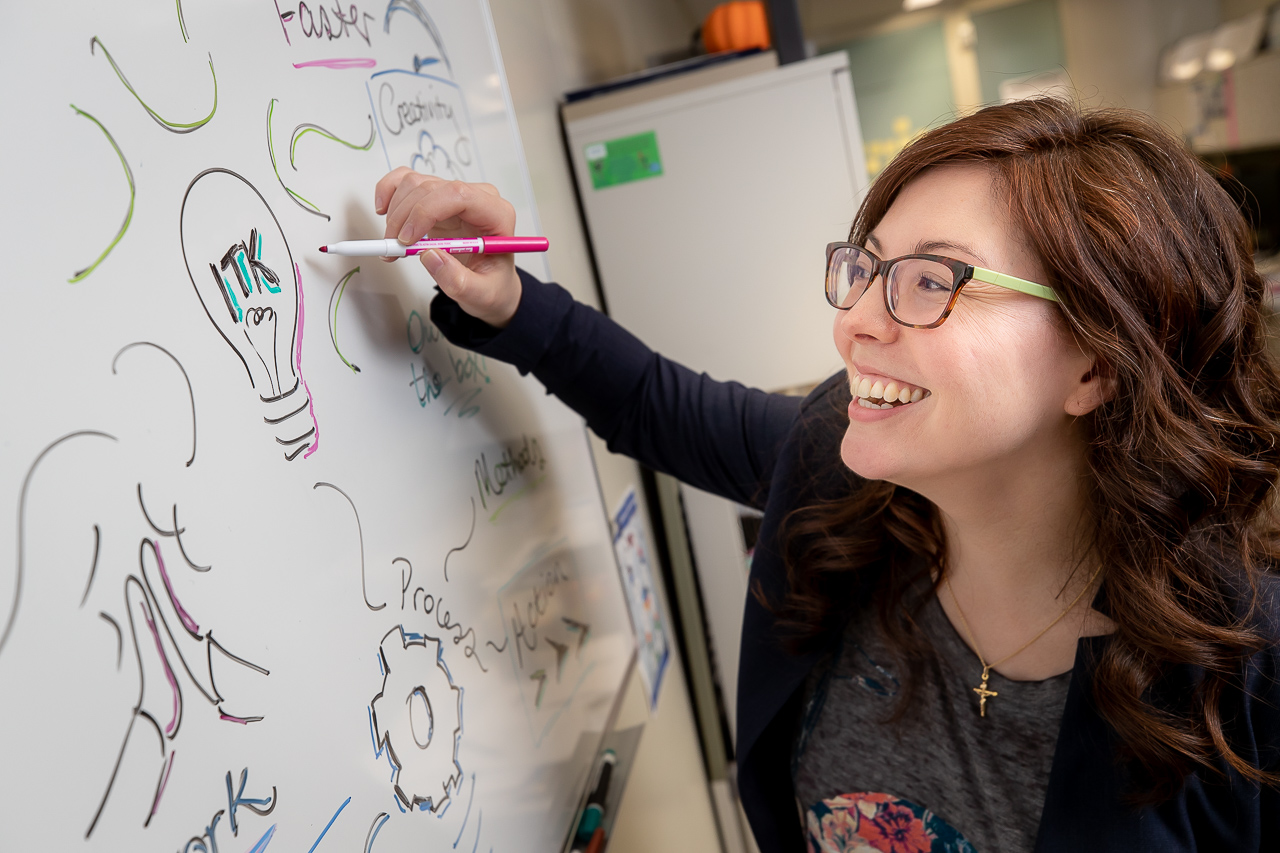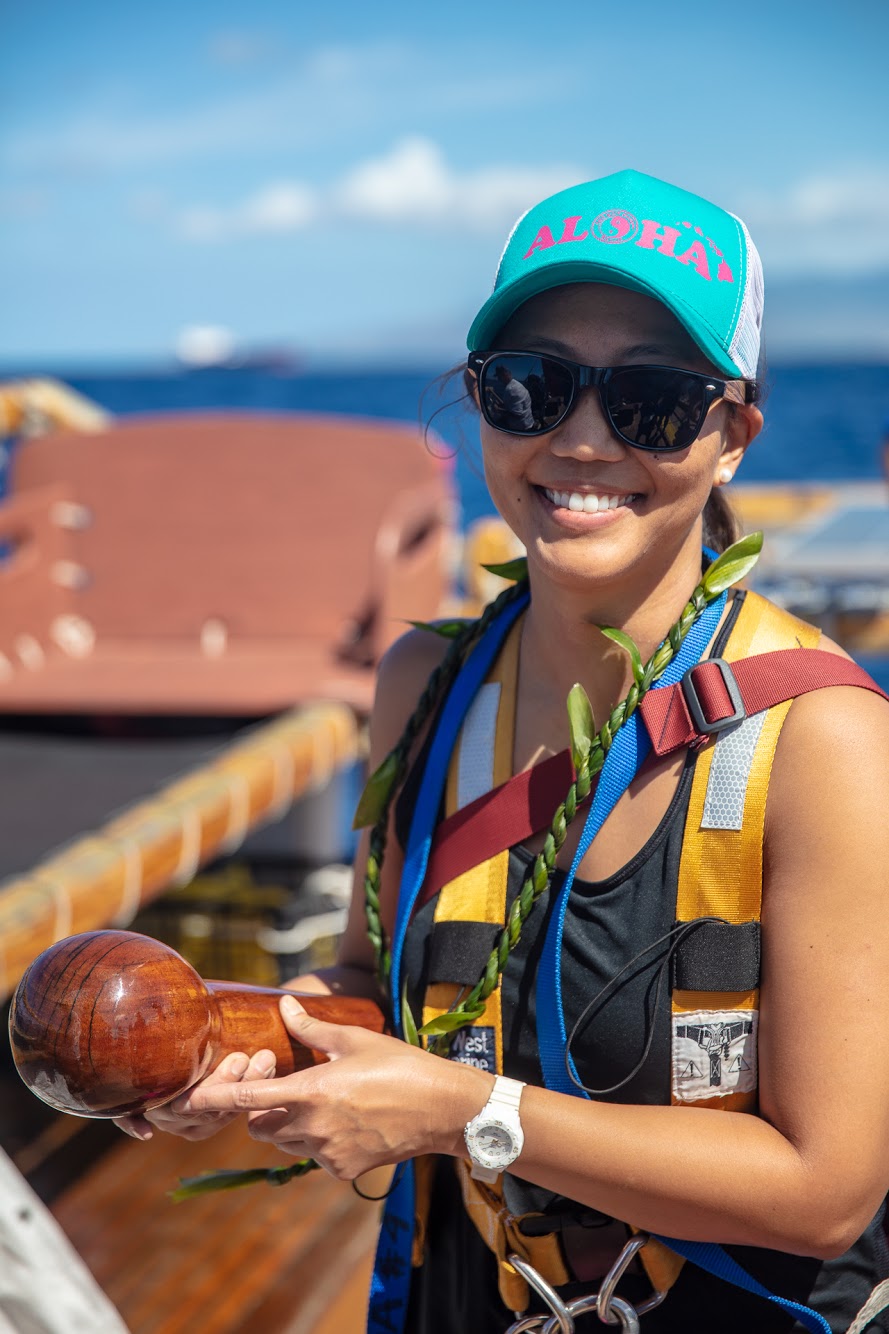
by rgregorio | Nov 4, 2019 | Interviews, Team Toolkit
Aileen Laughlin, Lead Systems Engineer, brings a long passion for technology, innovation, and user-centered design to Team Toolkit. Her enthusiasm and wild ideas bring an electric energy to the team, so I was looking forward to chatting with her about how she got here, where she finds inspiration, and what she sees for the future of ITK.
(Military) Family Matters
Moving around a lot as an “Army brat” and growing up on military bases fostered her interest in technology and all things military. In college, she was interested in product design and the human element of technology, leading her to human factors. She landed an internship with a major contractor and that was that! After a while, she became frustrated by her inability to help users or make progress on projects (see her article on why user-experience design is so tough). She joined MITRE where she could have more direct influence and impact. Working on ITK has allowed her return to her military routes and get the Toolkit in the hands of the warfighters to unleash their innovation!
Doing something different that makes a difference
Aileen is always trying to do more UX/UCD work since many don’t get that type of support. She believes that if more people understood design as a discipline, they would eliminate a big chunk of product and system problems. For the projects and programs Aileen supports, she feels rewarded to see people recognize the value and impact that comes from UX/UCD. She finds it most rewarding to help users be heard and get what they need for their jobs. With ITK, she helps people think and work differently, tapping into their inner innovator or inventor. Witnessing people in all their creative, curious, critical thinking glory collaborating with others to solve tough problems is a thing to behold.
Aileen loves to learn and is constantly sharing her findings with the team. She reads about what’s happening in the DoD (“These are exciting times!”) and technology, since it’s an interest of hers. On projects, she always want to know more about the context, landscape, or what’s new, sending her down the Google rabbit hole. Aside from Googling, she uses news aggregator apps, tagging topics of interest.
Tailoring toolkits
Admittedly obsessed with DIUx (now DIU) when former Secretary of Defense Ashton Carter announced the organization, Aileen was interested in getting MITRE involved. Understanding the user and understanding the problem is such a major part of any innovation venture. As she was looking across industry at innovative organizations that leverage the brain power of all their work force, she came across innovation toolkits.
A common theme in her research was the importance of tailoring toolkits for your group’s problems, organization, domain, and culture. Since MITRE and our sponsors are much more mission-driven, she was concerned terminology from a profit-driven company would reduce adoption and confuse users. Aileen reiterated the need to strike a balance between being respectful of people’s comfort zones while finding gentle ways to push them out of them.
Show, don’t tell
When asked about the best way to get people outside their comfort zones, Aileen recommended the “show, don’t tell” approach. She used bodystorming on one of her projects, where users brainstorm and work through a design using physical props. She explained in advance to her team that they’d move boxes around to find the ideal position for equipment. She could tell some people thought she was crazy when she arrived with labeled, duct-taped cardboard boxes matching the dimensions of different hardware. But once they packed into the truck and started moving the boxes around, people recognized the goodness. Find an instance where just doing things can make people believers.
Bodystorming is her favorite tool in the kit because it forces people to walk through something in its entirety. When people start to put an idea or concept through its paces, they can see where it starts to fall apart or maybe what might have been overlooked.
Challenging the status quo
Aileen’s innovation style? Nothing’s too wild + let’s just do it. With a “how can I make it better?” mentality, she has ideas coming and going all day. When she feels strongly about an idea, she want to execute right away before the fire is gone and something else catches her attention. She loves running her ideas by people – finding it eye-opening, informative and helpful to see things from another perspective. By the time an idea’s made its way through Team Toolkit, it’s evolved into something way more awesome.
She attributes culture change to finding the people in a group who are willing to question the status quo and ask questions. Aileen sees individuals as the catalyst for change and sees more people asking: “why do we keep working this way?” when there are better options. ITK methods can help you and your co-disruptors continue to ask some of those important questions. If you’re not sure how to start, Aileen recommends reaching out to someone on the team! Connecting with new, different people is oftentimes an undervalued part of innovation – so start with Team Toolkit.
Aileen’s dream for ITK is for people to feel empowered to use ITK on their own. That they adopt, adapt, and grow the toolkit for their needs and this creative, collaborative, critical thinking approach to problem solving becomes the new normal. Her vision for the future of ITK? Digging into the next set of really hard problems while eating 3D-printed failure cake on Mars.

by rgregorio | May 27, 2019 | Interviews, Team Toolkit
As part of our ongoing effort to democratize innovation across the company, Team Toolkit has picked up a couple of new members since we started. One of them is Jen Choi, a Senior Multi-disciplinary Systems Engineer at MITRE. Rachel sat down with Jen recently to learn a little more about her and formally introduce her to the community!
Rachel: Welcome to Team Toolkit, Jen! Can you tell us a little about yourself?
Jen: Hi Rachel! I’m stoked to be here with you and Team Toolkit. I joined MITRE last June and have had a pretty interesting path before arriving here… I have close to a decade of experience in engineering, but I also spent a few years as an entrepreneur, an executive coach, and a surfer: I had my own coaching business, and I also worked with a non-profit, Surfrider Spirit Sessions, where we “catch waves and change lives” by teaching at-risk youth how to surf and how to change their lives using lessons drawn from the ocean. I’ve been fortunate to have traveled the world for a year, and I also used to live and work abroad in the Netherlands. Before moving to Massachusetts, I was living in Hawai’i and began learning how to navigate using the stars and I’m currently a voyager with the Polynesian Voyaging Society.
R: How did you first get involved with Innovation Toolkit?
J: I worked with Dan on a sponsor project and the ITK team was brought on to support a workshop in the Pentagon. The team banded together to build the problem framing canvas and the Opportunity Capture canvas in a weekend. I had never heard the word ‘charter’ or ‘canvas’ before in this context and seeing the rapid tool-building was really cool – one person started it and then others contributed their ideas.
R: What’s your favorite part of being on Team Toolkit?
J: I love the energy of possibility – the openness, creativity, and willingness to think different and be different. And, that it’s encouraged and supported. In an engineering company, I think remembering the human aspects of design, rather than only thinking of systems, can help lead to innovation. Having a collection of these tools that are available to everyone and applying them in traditionally systems-oriented environments (military especially) feels really creative.
I like seeing the confidence boost when people realize they have something valuable to contribute. Using these tools becomes inclusive because everyone is invited to participate. You never know what cool idea is going to come from whomever.
Also, I like introducing people to a new idea and seeing how their perspectives and mindsets shift. That, to me, is really exciting; that’s the most powerful thing we can give to an individual. I’m all about the power of choice. Mindset is a big part of what Toolkit is about, both to help you shift your mindset and to help you articulate that.
R: Do you have an example of that?
J: When we used the problem framing tool with one of my sponsors who is very traditional, reserved, and likes to plan ahead, they were surprised by how much they could get done in an hour. They were beginning in a totally new domain and didn’t know where to start. We uncovered not just one problem, but many problems, and so
mething “fuzzy” started to clarify. They continue to be appreciative and champion this type of problem solving; they want to bring this to their leadership and other organizations!
R: What is the most challenging part of working with people and ITK?
J: Some people have a natural aversion or resistance to the tools. I’m starting to build my barometer of when a group is “ready” for toolkit or not. That can only be done by trial and error, which makes it the challenging part. Sometimes it will be a “hard no” and always be a no. Some are a “not yet” and you have to take that temperature pulse. When there’s trial and error, there will inevitably be errors. You need to figure out what went wrong…and be willing to try again.
On a more logistical note, the tools are the best when you have diversity of people in the room. Being able to get on people’s calendars can be a challenge. People are busy and have competing priorities, so it can be tough to even find time to use the tools.
R: Tell me about some of the people you’ve met while working in ITK.
J: Without Toolkit, I never would have gone into the Pentagon to facilitate a lot of senior leadership in the government! Using ITK was really cool because unlike traditional engagements where one is typically looking for a decision or guidance, the roles were reversed and we were guiding the senior leaders by drawing out their individual inputs and helping piece these together as a group.
R: How would you describe your style of innovation?
J: I encourage people to see the bigger picture and set goals based on their vision. When I was coaching, I helped people get unstuck and get clear on what they’re really trying to do. That’s how I use Toolkit now, which is probably why I like using the Problem Framing canvas.
R: What role does culture play in adoption of ITK methods?
J: Culture is huge. It’s great if you can find one person who is open, buys in, or who can be an ally/champion for the tools. We need to understand the culture of an organization or group to figure out who is receptive to ITK methods.

Internally on Team Toolkit, our culture is very diverse, which I think truly helps us create better tools and products. We represent different MITRE locations, remote vs. in-person, different types of engineering, and work with different sponsors.
R: Everyone has a favorite tool. Name yours and why?
J: The problem framing canvas is definitely my favorite; I use it so often. It’s so helpful for getting people on the same page about the problem we’re trying to solve. I reference the double diamond ALL the time! I also use the Lotus Blossom and Trimming a lot. Oftentimes, Lotus Blossom is helpful for getting ideas out. When I feel stuck, seeing the colors of the lotus blossom and putting thoughts on paper helps me to organize my thoughts. I truly do think I like it because it’s colorful. J
R: What do you do when you aren’t working on ITK?
J: I was living in Hawai’i right before joining MITRE, so I’m always on the lookout for good surf (even in freezing temperatures!). I’ve also continued my volunteer work with the Polynesian Voyaging Society and since now I’m on the mainland, I primarily focus on sharing about my experiences and lessons from voyaging and wayfinding. I’m super passionate about the ocean and navigating using the stars, so it was really cool to speak at this year’s MITRE’s TEDx event. When I’m going through life, I’m always thinking, “How can I relate this to the ocean or another experience?”
R: Do you see any connection between voyaging and ITK?
J: When you’re on a voyage and out in the ocean, all you have is your crew, the canoe, and whatever you’ve brought with you. You have to be resourceful and use what you have. As crew, we recognize that we all have different strengths, and we work together to help each other. We think ahead to make things easier for each other. When conditions become dangerous, it’s all hands on deck and everyone is helping, no matter who you are. There’s such strong mutual respect and aloha for each other; we really come together as a wa’a ohana (voyaging family).
This resonates with ITK too. Team Toolkit is a solid group of individuals that all contribute and have unique strengths. When a major task comes along, we all rally together to meet deadlines. I feel like we all have each other’s back, and similar to voyaging, I feel the tightness of this crew.
In voyaging, we’re going out to explore the oceans and faraway lands. With ITK, we’re going out to explore different hard problems and help people find solutions. In both groups, we take what we know and go beyond our “island” to spread this knowledge with others.
R: If someone was interested in using the Innovation Toolkit, how would you suggest they get started?
J: Reach out to Team Toolkit! It’s more fun to talk to a real person, and having someone really listen and being an outside listener can really help with giving perspective. We can suggest tools or toolchains that might help in your unique situation. If that’s not possible, then I would suggest looking at the categories of tools to help you identify where in the double diamond you are. Then, try using the tools on your own. See if it helps, and then try using the tools with your team. Team Toolkit can also help facilitate your session or share tips on how to effectively use the tools for the first time with your team.
R: Do you have a favorite quote to share?
J: The Maya Angelou quote, “If you don’t like it, change it. If you can’t change it, change your attitude.” To me, this quote reminds me of the power of choice: Things in our environment are out of our control, but you can always choose how you respond. Your attitude is completely up to you. This power of choice is accessible to everyone, like the Toolkit!
ITK truly is for everyone. ITK methods are different from traditional analytical or engineering approaches, and Toolkit can disrupt people’s perceptions of themselves: That yes, they are innovative, and that yes, they are the right user for these tools. I’ve struggled with this self-perception disruption, too! It took me a long time to recognize that I’m creative. ITK really is for everyone, and anyone can use it.
by rgregorio | May 13, 2019 | Uncategorized
When we’re given a new assignment at work, the first questions we often ask are:
- What needs to be done?
- How are we going to do it?
- When is it due?
- Who is it for?
These are each important questions that should not be missed, but there’s another question that we should make a point to ask and answer as soon as possible: “Why?” This deceptively simple question can come in many forms, such as:
- Why are we doing this project?
- Why is it important?
- Why am I the right person for the task?
Some might be apprehensive to ask their leader “Why?” for fear of being met with, “Because I said so!” It’s important to build a culture where the Why question is encouraged rather than dismissed. We assure you that answering the “why” of a project is never wasted time. Defining the why prevents us from wasting time going down the wrong path, missing opportunities, or focusing on the wrong aspects of a project.
A popular technique for getting to the true root of it all is “5 Why’s.” Because sometimes asking why once is not enough. Maybe the first one will get you to, “Because we want to make the process faster.” Why does the process need to go faster? Because our employees don’t have enough time to innovate. Why don’t they have enough time? As the question often enough and you just might arrive at a powerful, unexpected insight.
Understanding the purpose of a project will lead us to the root of the problem we’re trying to solve. Not sure what problem your project is trying to solve? Check out ITK’s Problem Framing tool. Use it alone or with your team. Building consensus around the mad-lib-like problem across the bottom will provide your group with a measure of success and a goal to work towards, and make sure you all know why you’re doing what you’re doing.
by rgregorio | Apr 22, 2019 | Team Toolkit

Photo by Hunter Haley on Unsplash
When you hear the word “toolkit,” the automatic image that enters your mind is probably a metal box tucked away in a garage filled with home improvement tools.
However, toolkits have been around for almost 3.3 million years. We use them in our lives all the time even though we might not know it. Where did toolkits come from? The first Toolkit originated from Lomekwi 3 in West Turkana, Kenya. It was made up of basic tools like stone hammers and stones that were sharpened to cut or smash wood and food.
All toolkits are different but they all are similar in one way. They help make our lives easier and do things more efficiently and simpler.
Not all toolkits are made up of drills, hammers and screw drivers. Some are made up of methods or processes like the MITRE Innovation Toolkit (ITK). More modern toolkits are used for innovation and creative problem-solving. This new concept helps the user figure out solutions in a more effective way. They also have the ability to adapt the tools for their own purpose and perspective. Like ITK, we have tools that make the users look at possibilities, causes, and solutions to their problem by laying out their thoughts out on paper for a more collaborative effect.
Even after 3.3 million years, we still go back to that same concept of using and creating toolkits to help make our lives easier and be more efficient. What would you put in your toolkit?






